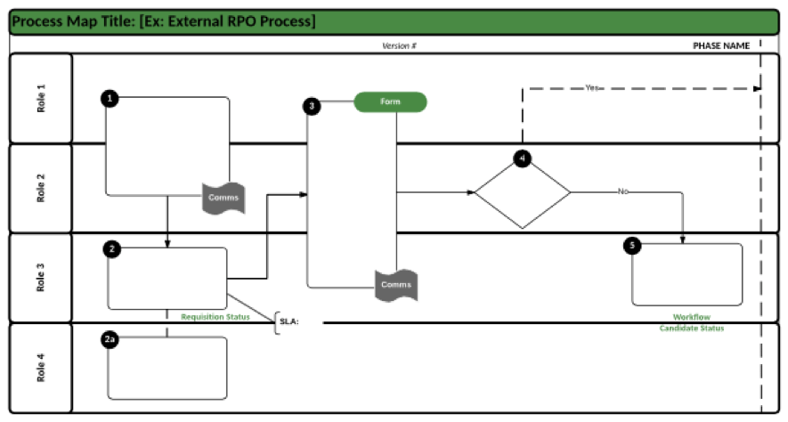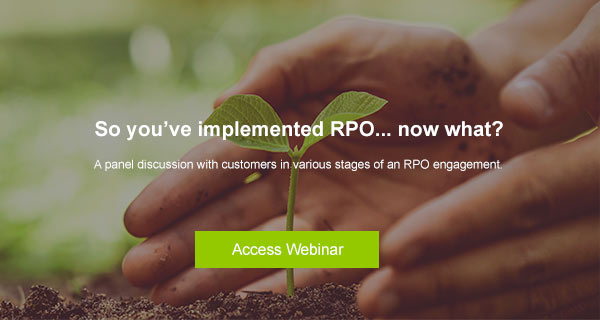 In our previous article “Understanding the RPO Process” we wrote about the key activities that, as a client, you should look for during the implementation of a recruitment process outsourcing (RPO) process. In this article, we will walk you through what we call, “The Process Experience” of an RPO implementation.
In our previous article “Understanding the RPO Process” we wrote about the key activities that, as a client, you should look for during the implementation of a recruitment process outsourcing (RPO) process. In this article, we will walk you through what we call, “The Process Experience” of an RPO implementation.
You are probably asking yourself what is “The Process Experience”? We define it as the process of collecting, reviewing, revamping and communicating the recruiting information needed to design the RPO process map.
First, the data
Once a client has entered into a new RPO partnership, it is the responsibility of the RPO Implementation Manager to begin the data collection. This activity is critical and a key milestone to achieve within any implementation. Each RPO provider has different ways of obtaining the information whether via e-mail in the form of a survey, telephone questionnaire or face to face meeting. As Implementations Consultants, we advise RPOs to take into consideration the client’s culture to find a method that will best suit them to get the most information possible.
Gathering the data will determine how many processes should be designed to reflect all hiring types; for example, external hiring, internal hiring, agency recruiting, etc. When dealing with a multi-country implementation, there should be one survey per country. During this activity, the Implementation Manager will ask questions such as:
- Define your requisition initiation process. Who initiates a requisition? Who approves? How is a requisition initiated (through ATS, paper form, verbal communication, etc.)?
- Currently, are all candidates directed to submit their information / apply online through your website's Career Portal, or do you accept resumes/CVs/applications in other formats?
- Do Hiring Managers currently conduct phone interviews with candidates? If yes, please describe the phone interview process. Who schedules the phone interview?
The timeframe to collect the data varies depending on the amount of countries, response rate and quality. It is common for the Implementation Manager or Process Designer to go back to confirm specific information. This can take between 1-3 weeks, but once date collection is complete, the fun starts for the designer!
Then, the process maps
The Implementation Manager or Process Designer will read, review and compare all responses to draft out a current state process map. This current state process map will be revised with the client to make sure nothing has been missed – then you are ready to design the future state process map. At Mynt Consultants, we utilize a stencil to document the step by step instructions. If an action happens 80% of the time it will be a process step, if it happens 20% it will be out of the process and documented separately. On the image below you will find a sample of a stencil depicting different elements.

Swim Lanes: Every process map will have what we call swim lanes holding the name of the role responsible for the step. Depending on the RPO model the amount of swim lanes varies but 4-6 is the average; for example, Human Resources, Hiring Manager, Staffing Consultant, Recruiter, Coordinator, etc. The names will change from client to client, taking into consideration what their managers will embrace the most.
Numbering: The process should have numbers or indicators as to how to follow the steps within the process. At the very top it should always include the current version to keep track of changes throughout the program.
Shapes & Steps: The shapes reference the type of action to be taken within that step. There are two main shapes in this sample: the rectangle referencing a process step, a diamond referencing a decision-making step. You will also find small shapes that reference which form needs to be utilized to carry out the step and/or what communications should be sent out.
ATS Status: Throughout the map there will be several steps- and “yes trust me you will want to document them because it will help you to obtain accurate reporting.” The map should have candidate steps and statuses as well as requisition statuses. As a side note the service level agreement (SLA) goal will be entered on each status.
Lines: The straight line will be a standard connector between steps, and dotted lines will be indicators of simultaneous responsibilities or off page/alternate page connector. When the dotted line is placed vertically across page it will act as a phase separator.
The main purpose behind process mapping is to assist organizations in becoming more effective. After current state process confirmation, it takes approximately one week to design the future state process map. This will be reviewed in extreme detail with the client key stakeholders to obtain approval and sign off.
Collecting, reviewing, revamping and communicating the recruiting information needed to design the process map are key elements of the Process Experience. The one reference document that everyone should follow in a Process Experience is the process map. Therefore, a clear and detailed process map is the key to program success!
Suggested reading: RPO Implementation - Understanding the Process.
***
About the authors: Maru Gonzalez and Cynthia Cohen are co-founders of Mynt Consultants, a company offering RPO/Recruitment Project Management Services, particularly in Process Design and Engineering, ATS Implementation and Training, as well as Change Management and Continuous Process Improvement.















